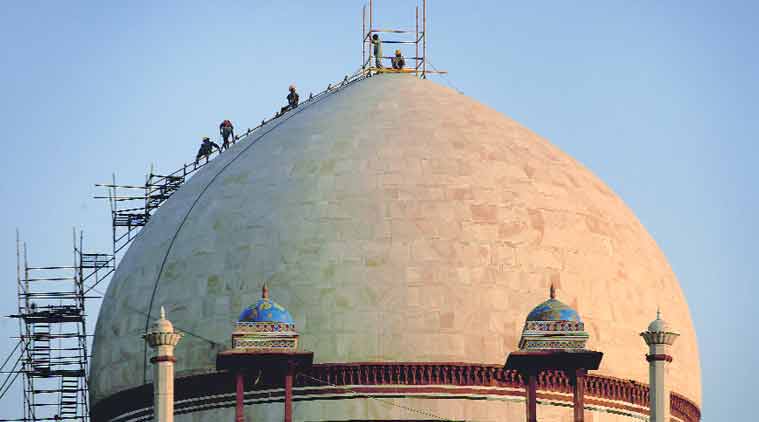Stay updated with the latest - Click here to follow us on Instagram
Humayun’s Tomb to get new, lookalike finial
On May 30 last year, the 18-foot finial, weighing 225 kg, collapsed during the storm.
 The missing finial after last year’s storm. (Source: express Archive)
The missing finial after last year’s storm. (Source: express Archive)
More than seven months after a storm in the capital broke the finial of Humayun’s Tomb, the Archaeological Survey of India (ASI) has approved the conservation proposal prepared by Aga Khan Trust for Culture (AKTC) for necessary repair and restoration.
While the original finial will be repaired and placed in a museum, an identical one will be prepared and installed atop the dome.
On May 30 last year, the 18-foot finial, weighing 225 kg, collapsed during the storm. The original finial has 11 copper vessels covered in a gold finish and a brass crown. A study for repair and restoration was carried out by the ASI-AKTC team and after initial discussions, AKTC was formally asked to prepare the report on June 26.
Though AKTC submitted its report on July 16, it was approved by ASI on December 31. “We took time to approve the project as we had sent samples from the broken finial to IIT-Kanpur and ASI’s chemical laboratory in Uttarakhand to corroborate AKTC’s findings,” ASI director general Rakesh Tiwari told Newsline.
While preparing the report, AKTC relied on archival research which revealed that the finial had been dismantled and repaired in 1912. Visual inspection of each of the vessels for inscriptions and artwork on the finial was also done. Researchers also carried out the structural analysis of the copper vessels that the finial is made of as well as the octagonal Sal wood that forms the core. The cavity of the dome was cleaned and cement used in the 20th century was removed.
The report, officials said, showed that the 11 vessels were in a friable state and had been repaired several times over the last five centuries. “Each of the vessel was weighed and studied separately to allow comparisons with the original profile. The Sal wood had pulverised due to water retention and cement used for repair in the late 20th century had blocked the water outlet. The finial elements contained inscriptions and artwork — such as depictions of a praying man — that are considered to be of immense art history interest,” the ASI-approved report read.
According to the report, the original finial will be repaired and placed at Humayun’s Tomb Site Interpretation Centre. A new finial, matching the original, will be prepared and installed at Humayun’s Tomb. “This will require 225 kg of pure copper (99 per cent as revealed by reports by Shriram, IIT-Kanpur, and ASI science branch) as well as a 24-foot tall single wooden pole. Each vessel will be a match to the original. In keeping with the conservation philosophy of Humayun’s Tomb conservation, traditional craftsmen from across the country will be engaged,” the report said.
AKTC project director Ratish Nanda told Newsline that the crown of the finial has been found to be a single cast of brass. “The finial is the most prominent architectural element at Humayun’s Tomb. It also demonstrates the advances of metallurgy in 16th century India. The finial will be restored using traditional craftsmanship and state of art scientific research,” Nanda said.







